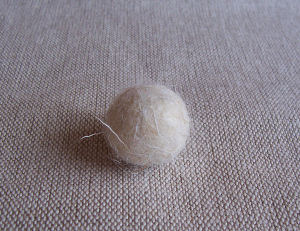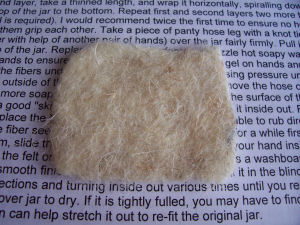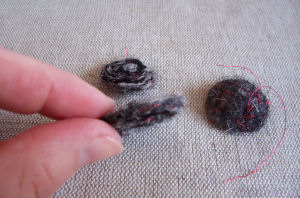This is what I produced within 1,5 hours I had for myself today and I would like to tell you more about my recent discoveries – if you are somewhere at the beginning of your felting adventures then. If not than you probably know all of this.
As I said yesterday the first time I have touched merino was last month. I had no clue what it exactly is and that differencies between wools can be great with the big impact on how succesful felting will turn out. But i wanted to felt more and wanted to felt in natural colours so I bought some wool on e-bay.
But, only when it arrived I have noticed that it doesn’t look at all like merino we used with Caroline and that’s where my research has started. I was afraid it would be good mainly for spinning (that’ s what the seller sells it for) but not for felting. So after checking books in a local bookshop and a lot of googling I have learned that
* different breeds give different types of wool
* every wool felts to some degree, but some felts easily and quickly, some very slowly
* the choice of a wool depends on what we want to make from it eg. fine wool like merino is suitable for fine garments with a good drape but unsuitable for hardwearing objects as it wears off quicklyFiber thickness is an important factor in the quality of wool and is usually classified in the UK by the Bradford Count system – the higher the number, the finer the wool. In other parts of the world fibre thickness is measured in microns, which is a measurement of fibre width (one micron = one millionth of a metre). The lower the number the finer the wool. (Felt to Stitch by Sheila Smith, p. 9 – probably the most comprihensive book on felting for embroiderers.)
I won’t repeat what others have said so here are some very helpful links if you want to know more about different types of wool and their use for felting:
- Suitability of wool for felting and Testing wool for felting purposes – many thanks to Lovefibre for providing these links
- The British Wool Marketing Board
- Wingham wool Work – supplier, but has got some general info about suitability as well
- Moral Fibre – dtto
Here are some other good sites with lots of information about feltmaking:
-
TextileArts – huge amount of information!!!
-
Owning Alpaca – info about felting with alpaca fibre (different from sheep’swool – nonalergic)
-
Sally Pointer – interesting info about how to make shoe lasts for future felted slippers
-
Stitch with the EG, issue no 51, p. 46 – very good article on couple of pages by Joanna O’Neill
Here are some facts I have learnt, just for a brief comparison:
When felting some sort of soap is needed. This is what people use: bar of soap (with olive oil – good for hands), soap flakes, washing detergent. It is then dissolved in hot water.
For wrapping in fibres the following is used to agitate them: bubble wrap bubble side up, bamboo blind, bamboo beach mat, rush mat. To keep fibres from shifting: tull, polyester net curtaining, muslin, plastic grid shelf-liner, solar pool covering, lightweight calico, old stockings with 3-D objects like balls and vessels.
Taft of the fibres are either pulled from the end or are cut by scissors.
For wrapping fibres around: wooden dowel, foam “stick” used at the swimming pool (look at this Nuno felt tutorial at Sharon’s B. site).
As for my today’s experiments: every wool which I have at home felted very well!
Merino roving is very fine and felts quickly leaving no residue on hands.
Black Alpaca felted as quickly as merino but left some fibres on my hands and in the water (making balls). I have made one pure alpaca ball and one blended 1:1 with white Welsh wool as I read somewhere that adding wool adds elasticity and gives better results. I also added some sparkly embroidery thread.
White Welsh wool felted slower than the previous two but still quickly enough. It is rougher but looks more woolish than merino. It shrinked cca by 50 %.
I cut the white in halves and sliced the blended one with an ordinary knif (sources say you can use craft knife and even electric knife). You can see the marbled inner part on the picture above. Btw., both these fibres give more fuzzy look and are messier to work with, merino ball is much smoother.
The biggest ball I made by wrapping woolen knitting yarn into a little ball loosly and then felting. The end of the yarn kept untangling so I finaly added a thin layer of merino to keep it on a place. It worked. The ball is felted to some degree, it is still very soft, I will probably put it in the washing machine.
Please, go to my Flickr account, if you would like to see larger pictures.





Wow, thanks for all this brilliant information!!
You really have been busy!!
Caroline
: )
THANK YOU for this wonderful post on felting. I am printing out the entire post to read and use! I would really like to try felting!
-Emily in Norway
Emily, you are most welcome! It took me the whole evening to write it but I was sure there must be someone out there who would find it useful. So thank you for the feedback!
TRY IT!
There were two things which kept me back:
I thought the wool itself is expensive, like 3 £ for 100 g, But 100 g of LIGHT wool is quite a big bag and cca 3 A4 sheets of finished felt.
And the process itself I thought would be complicated. But it isn’t although as you see I needed to sort my thoughts and understand it a bit before I felted on my own.
thanks for all the links and information. I love the organised way you approach this – it’s inspiring.
Thanks, good article. Do you know any other places that discuss this?
If you check the above links, I think there is all what you need to know about felting, at least at the beginning…
weLL…
it is very interesting since I am interested in this kind of handycraft..
but actually I’m still confusing how to make felt beads or how to wrap it…
would you explain more clearly for me,pLease?
or perhaps you can inform me where I can get this information?
thanks aLot.
-Serafita (Indonesia)-
We breed Arapawa sheep on our hobby farm in New Zealand and their fleece is ideal for felting. I sell washed and carded slivers on TradeMe (the New Zealand equivalent of eBay) and have already sent some to Australia. Arapawas are a rare, feral breed and although the staple is short, it has Merino-like qualities and comes in a variety of shades from beige to dark brown. A garment felted entirely from our fleece was successfully chosen as an entry in the 2009 World of Wearable Arts Show. Although it didn’t win, it was great to see it on the catwalk. A wonderful crinoline dress made entirely of wood won the overall award – made by a woodsman from Canada!
I found your post of great information. You’re so good to give us such details and links. Thank you.
I have always been intrigued by felting and would love to learn. I wish I didn’t have so much on my plate! You do wonderful work and I may not have time now, but maybe one day…thank you ahead of time for this post on felting for beginners! All the best to you, Koko ❀ ✿ ❁ ✾